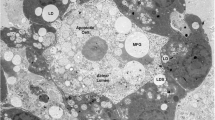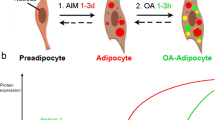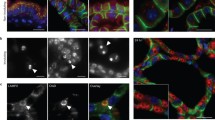Abstract
Mammary epithelial cells (MEC) secrete fat in the form of milk fat globules (MFG) which are found in milk in diverse sizes. MFG originate from intracellular lipid droplets, and the mechanism underlying their size regulation is still elusive. Two main mechanisms have been suggested to control lipid droplet size. The first is a well-documented pathway, which involves regulation of cellular triglyceride content. The second is the fusion pathway, which is less-documented, especially in mammalian cells, and its importance in the regulation of droplet size is still unclear. Using biochemical and molecular inhibitors, we provide evidence that in MEC, lipid droplet size is determined by fusion, independent of cellular triglyceride content. The extent of fusion is determined by the cell membrane’s phospholipid composition. In particular, increasing phosphatidylethanolamine (PE) content enhances fusion between lipid droplets and hence increases lipid droplet size. We further identified the underlying biochemical mechanism that controls this content as the mitochondrial enzyme phosphatidylserine decarboxylase; siRNA knockdown of this enzyme reduced the number of large lipid droplets threefold. Further, inhibition of phosphatidylserine transfer to the mitochondria, where its conversion to PE occurs, diminished the large lipid droplet phenotype in these cells. These results reveal, for the first time to our knowledge in mammalian cells and specifically in mammary epithelium, the missing biochemical link between the metabolism of cellular complex lipids and lipid-droplet fusion, which ultimately defines lipid droplet size.






Similar content being viewed by others
References
Walther TC, Farese RV Jr. The life of lipid droplets. Biochim Biophys Acta. 2009;1791(6):459 – 66.
Wojczynski MK, Glasser SP, Oberman A, Kabagambe EK, Hopkins PN, Tsai MY, et al. High-fat meal effect on LDL, HDL, and VLDL particle size and number in the Genetics of Lipid-Lowering Drugs and Diet Network (GOLDN): an interventional study. Lipids Health Dis. 2011;10:181.
Pan X, Wilson M, McConville C, Arvanitis TN, Kauppinen RA, Peet AC. The size of cytoplasmic lipid droplets varies between tumour cell lines of the nervous system: a 1H NMR spectroscopy study. MAGMA. 2012;25(6):479 – 85.
Nunn AD, Scopigno T, Pediconi N, Levrero M, Hagman H, Kiskis J, et al. The histone deacetylase inhibiting drug Entinostat induces lipid accumulation in differentiated HepaRG cells. Sci Rep. 2016;6:28025.
Krahmer N, Guo Y, Wilfling F, Hilger M, Lingrell S, Heger K, et al. Phosphatidylcholine synthesis for lipid droplet expansion is mediated by localized activation of CTP:phosphocholine cytidylyltransferase. Cell Metab. 2011;14(4):504 – 15.
Liang WC, Nishino I. State of the art in muscle lipid diseases. Acta Myol. 2010;29(2):351–6.
Cohen JC, Horton JD, Hobbs HH. Human fatty liver disease: old questions and new insights. Science. 2011;332(6037):1519–23.
Reddy JK, Rao MS. Lipid metabolism and liver inflammation. II. Fatty liver disease and fatty acid oxidation. Am J Physiol Gastrointest Liver Physiol. 2006;290(5):G852–G8.
den Hartigh LJ, Connolly-Rohrbach JE, Fore S, Huser TR, Rutledge JC. Fatty acids from very low-density lipoprotein lipolysis products induce lipid droplet accumulation in human monocytes. J Immunol. 2010;184(7):3927–36.
Argov N, Lemay DG, German JB. Milk fat globule structure & function; nanoscience comes to milk production. Trends Food Sci Technol. 2008;19(12).
Mesilati-Stahy R, Mida K, Argov-Argaman N. Size-dependent lipid content of bovine milk fat globule and membrane phospholipids. J Agric Food Chem. 2011;59(13):7427–35.
Lu J, Argov-Argaman N, Anggrek J, Boeren S, van Hooijdonk T, Vervoort J, et al. The protein and lipid composition of the membrane of milk fat globules depends on their size. J Dairy Sci. 2016;99(6):4726–38.
Mizuno K, Hatsuno M, Aikawa K, Takeichi H, Himi T, Kaneko A, et al. Mastitis is associated with IL-6 levels and milk fat globule size in breast milk. J Hum Lact. 2012;28(4):529 – 34.
Logan A, Auldist M, Greenwood J, Day L. Natural variation of bovine milk fat globule size within a herd. J Dairy Sci. 2014;97(7):4072–82.
O’Mahony JA, Auty MA, McSweeney PL. The manufacture of miniature Cheddar-type cheeses from milks with different fat globule size distributions. J Dairy Res. 2005;72(3):338 – 48.
Michalski MC, Gassi JY, Famelart MH, Leconte N, Camier B, Michel F, et al. The size of native milk fat globules affects physico-chemical and sensory properties of Camembert cheese. Lait. 2003;83:131–43.
Smoczyński M. Role of Phospholipid Flux during Milk Secretion in the Mammary Gland. J Mammary Gland Biol Neoplasia. 2017;22(2):117–29.
Rambold AS, Cohen S, Lippincott-Schwartz J. Fatty acid trafficking in starved cells: regulation by lipid droplet lipolysis, autophagy, and mitochondrial fusion dynamics. Dev Cell. 2015;32(6):678 – 92.
Bickel PE, Tansey JT, Welte MA. PAT proteins, an ancient family of lipid droplet proteins that regulate cellular lipid stores. Biochim Biophys Acta. 2009;1791(6): 419 – 40.
Russell TD, Schaack J, Orlicky DJ, Palmer C, Chang BH, Chan L, et al. Adipophilin regulates maturation of cytoplasmic lipid droplets and alveolae in differentiating mammary glands. J Cell Sci. 2011;124(Pt 19):3247–53.
Fei W, Shui G, Zhang Y, Krahmer N, Ferguson C, Kapterian TS, et al. A role for phosphatidic acid in the formation of “supersized” lipid droplets. PLoS Genet. 2011;7(7):e1002201.
Guo Y, Walther TC, Rao M, Stuurman N, Goshima G, Terayama K, et al. Functional genomic screen reveals genes involved in lipid-droplet formation and utilization. Nature. 2008;453(7195):657 – 61.
Cohen BC, Shamay A, Argov-Argaman N. Regulation of lipid droplet size in mammary epithelial cells by remodeling of membrane lipid composition-a potential mechanism. PLoS One. 2015;10(3):e0121645.
Couvreur S, Hurtaud C, Marnet PG, Faverdin P, Peyraud JL. Composition of milk fat from cows selected for milk fat globule size and offered either fresh pasture or a corn silage-based diet. J Dairy Sci. 2007;90(1):392–403.
Walstra P. Studies on milk fat dispersion. II. The globule size distribution of cow’s milk. Neth Milk Dairy J. 1969;23:99–110.
King JOL. The association between fat percentage of cow’s milk and the size and number of fat globules. J Dairy Res. 1957;24:198–200.
Thiam AR, Farese RV Jr, Walther TC. The biophysics and cell biology of lipid droplets. Nat Rev Mol Cell Biol. 2013;14(12):775 – 86.
Düzgüneş N, Wilschut J, Fraley R, Papahadjopoulos D. Studies on the mechanism of membrane fusion. Role of head-group composition in calcium- and magnesium-induced fusion of mixed phospholipid vesicles. Biochim Biophys Acta. 1981;642(1):182 – 95.
Haque ME, McIntosh TJ, Lentz BR. Influence of lipid composition on physical properties and peg-mediated fusion of curved and uncurved model membrane vesicles: “nature’s own” fusogenic lipid bilayer. Biochemistry. 2001;40(14):4340–8.
Shi X, Li J, Zou X, Greggain J, Rødkær SV, Færgeman NJ, et al. Regulation of lipid droplet size and phospholipid composition by stearoyl-CoA desaturase. J Lipid Res. 2013;54(9):2504–14.
Walker AK, Jacobs RL, Watts JL, Rottiers V, Jiang K, Finnegan DM, et al. A conserved SREBP-1/phosphatidylcholine feedback circuit regulates lipogenesis in metazoans. Cell. 2011;147(4):840 – 52.
Masedunskas A, Chen Y, Stussman R, Weigert R, Mather IH. Kinetics of milk lipid droplet transport, growth, and secretion revealed by intravital imaging: lipid droplet release is intermittently stimulated by oxytocin. Mol Biol Cell. 2017;28(7):935 – 46.
Monks J, Dzieciatkowska M, Bales ES, Orlicky DJ, Wright RM, McManaman JL. Xanthine oxidoreductase mediates membrane docking of milk-fat droplets but is not essential for apocrine lipid secretion. J Physiol. 2016;594(20):5899 – 921.
Boström P, Andersson L, Rutberg M, Perman J, Lidberg U, Johansson BR, et al. SNARE proteins mediate fusion between cytosolic lipid droplets and are implicated in insulin sensitivity. Nat Cell Biol. 2007;9(11):1286–93.
Vance JE. Phospholipid synthesis and transport in mammalian cells. Traffic. 2015;16(1):1–18.
Leonardi R, Frank MW, Jackson PD, Rock CO, Jackowski S. Elimination of the CDP-ethanolamine pathway disrupts hepatic lipid homeostasis. J Biol Chem. 2009;284(40):27077–89.
Albright CD, da Costa KA, Craciunescu CN, Klem E, Mar MH, Zeisel SH. Regulation of choline deficiency apoptosis by epidermal growth factor in CWSV-1 rat hepatocytes. Cell Physiol Biochem. 2005;15(1–4):59–68.
Niculescu MD, Yamamuro Y, Zeisel SH. Choline availability modulates human neuroblastoma cell proliferation and alters the methylation of the promoter region of the cyclin-dependent kinase inhibitor 3 gene. J Neurochem. 2004;89(5):1252–9.
Voelker DR. Disruption of phosphatidylserine translocation to the mitochondria in baby hamster kidney cells. J Biol Chem. 1985;260(27):14671–6.
Jacobs RL, Lingrell S, Zhao Y, Francis GA, Vance DE. Hepatic CTP:phosphocholine cytidylyltransferase-alpha is a critical predictor of plasma high density lipoprotein and very low density lipoprotein. J Biol Chem. 2008;283(4):2147–55.
Boström P, Rutberg M, Ericsson J, Holmdahl P, Andersson L, Frohman MA, et al. Cytosolic lipid droplets increase in size by microtubule-dependent complex formation. Arterioscler Thromb Vasc Biol. 2005;25(9):1945–51.
Murphy S, Martin S, Parton RG. Quantitative analysis of lipid droplet fusion: inefficient steady state fusion but rapid stimulation by chemical fusogens. PLoS One. 2010;5(12):e15030.
Barber MC, Clegg RA, Travers MT, Vernon RG. Lipid metabolism in the lactating mammary gland. Biochim Biophys Acta. 1997;1347(2–3):101 – 26.
Schanche JS, Schanche T, Ueland PM. Inhibition of phospholipid methylation in isolated rat hepatocytes by analogues of adenosine and S-adenosylhomocysteine. Biochim Biophys Acta. 1982;721(4):399–407.
Zivkovic AM, Bruce German J, Esfandiari F, Halsted CH. Quantitative lipid metabolomic changes in alcoholic micropigs with fatty liver disease. Alcohol Clin Exp Res. 2009;33(4):751–8.
Vance DE, Ridgway ND. The methylation of phosphatidylethanolamine. Prog Lipid Res. 1988;27(1):61–79.
Hörl G, Wagner A, Cole LK, Malli R, Reicher H, Kotzbeck P, et al. Sequential synthesis and methylation of phosphatidylethanolamine promote lipid droplet biosynthesis and stability in tissue culture and in vivo. J Biol Chem. 2011;286(19):17338–50.
Farber SA, Slack BE, Blusztajn JK. Acceleration of phosphatidylcholine synthesis and breakdown by inhibitors of mitochondrial function in neuronal cells: a model of the membrane defect of Alzheimer’s disease. FASEB J. 2000;14(14):2198 – 206.
Rector RS, Thyfault JP, Morris RT, Laye MJ, Borengasser SJ, Booth FW, et al. Daily exercise increases hepatic fatty acid oxidation and prevents steatosis in Otsuka Long-Evans Tokushima Fatty rats. Am J Physiol Gastrointest Liver Physiol. 2008;294(3):G619–G26.
Gao G, Chen FJ, Zhou L, Su L, Xu D, Xu L, et al. Control of lipid droplet fusion and growth by CIDE family proteins. Biochim Biophys Acta. 2017;1862(10 Pt B):1197 – 204.
Wang W, Lv N, Zhang S, Shui G, Qian H, Zhang J, et al. Cidea is an essential transcriptional coactivator regulating mammary gland secretion of milk lipids. Nat Med. 2012;18(2):235 – 43.
Mudd AT, Alexander LS, Berding K, Waworuntu RV, Berg BM, Donovan SM, et al. Dietary prebiotics, milk fat globule membrane, and lactoferrin affects structural neurodevelopment in the young piglet. Front Pediatr. 2016;4:4.
Timby N, Domellöf E, Hernell O, Lönnerdal B, Domellöf M. Neurodevelopment, nutrition, and growth until 12 mo of age in infants fed a low-energy, low-protein formula supplemented with bovine milk fat globule membranes: a randomized controlled trial. Am J Clin Nutr. 2014;99(4):860–8.
Timby N, Hernell O, Vaarala O, Melin M, Lönnerdal B, Domellöf M. Infections in infants fed formula supplemented with bovine milk fat globule membranes. J Pediatr Gastroenterol Nutr. 2015;60(3):384–9.
Folch J, Lees M, Sloane Stanley GH. A simple method for the isolation and purification of total lipides from animal tissues. J Biol Chem. 1957;226(1):497–509.
Bionaz M, Loor JJ. Identification of reference genes for quantitative real-time PCR in the bovine mammary gland during the lactation cycle. Physiol Genomics. 2007;29(3):312–9.
Harvatine KJ, Bauman DE. SREBP1 and thyroid hormone responsive spot 14 (S14) are involved in the regulation of bovine mammary lipid synthesis during diet-induced milk fat depression and treatment with CLA. J Nutr. 2006;136(10):2468–74.
Acknowledgements
The authors would like to acknowledge Dr. Sergei Grigoryan for his assistance in confocal microscopy imaging. This research was partially supported by the Nutrigenomics Center of the Hebrew University of Jerusalem, Israel, and by the Israeli Dairy Board grant #8200327.
Author information
Authors and Affiliations
Corresponding author
Ethics declarations
Conflict of Interest
The authors declare no conflict of interest.
Electronic supplementary material
Below is the link to the electronic supplementary material.
Lipid droplet fusion. Representative fusion event of two lipid droplets, observed in MEC treated with 100 μM palmitic acid + 10 μM DZA and stained for their lipid droplets with Nile red. Optical sections were recorded with time-lapse imaging and reconstructed as 3D images from deconvolved images. Arrows indicate a pair of fusing lipid droplets. (AVI 78 KB)
10911_2017_9386_MOESM2_ESM.tif
DZA addition has no effect on live cell number compared to palmitic acid alone. Number of live cells determined by Trypan blue staining was similar in MEC treated with 10 μM DZA+100 μM palmitic acid relative to palmitic acid alone, both for 24 h. Data are presented as mean ± SD. (TIF 29 KB)
10911_2017_9386_MOESM3_ESM.tif
Time and dose response for NaN3 + NaF and oleic acid treatments. a Addition of 5 mM NaN3 + 20 mM NaF to medium containing 100 μM oleic acid eliminated MEC presenting large lipid droplets (>2.5 μm) from culture. Distribution of MEC phenotype, distinguished by the presence or absence of large lipid droplets after 24 h of treatment, was determined by chi-square test (P ≤ 0.05). b Phospholipid composition (weight %) of MEC treated as in (a) shows lower PE and higher sphingomyelin percent in oleic acid + NaN3 + NaF treatment relative to oleic acid alone. Data are presented as mean ± SD (*P ≤ 0.05). c, d Effects of NaN3 + NaF + oleic acid concentration and duration of treatment on live cell number. c 5 mM NaN3 + 20 mM NaF in the presence of 100 μM oleic acid for 24 h decreased the number of cells relative to treatment with oleic acid alone. d 2.5 mM NaN3 + 10 mM NaF in the presence of 360 μM oleic acid did not change live cell number relative to oleic acid alone after 2 and 4 h of treatment. Number of live cells was determined by Trypan blue staining. e MEC treated with 360 μM oleic acid + 2.5 mM NaN3 + 10 mM NaF presented smaller droplets relative to oleic acid alone after 4 h of treatment. Neutral lipids were stained with Nile red (red) and nuclei were stained with DAPI (blue). Scale bars, 20 μm. Data are presented as mean ± SD (*P ≤ 0.05). (TIF 912 KB)
Relatively slow movement of lipid droplets in MEC treated with oleic acid + NaN3 + NaF. Time-lapse imaging of Nile red-stained lipid droplets in MEC treated with 360 μM oleic acid + 2.5 mM NaN3 + 10 mM NaF reveals slower movement relative to oleic acid alone (see Online Resource <link rid="Sec22">5</link>). (AVI 199 KB)
Lipid droplet movement in MEC treated with oleic acid. Time-lapse imaging of Nile red-stained lipid droplets in MEC treated with 360 μM oleic acid reveals rapid movement and noticeable fusion between lipid droplets. (AVI 286 KB)
10911_2017_9386_MOESM6_ESM.tif
Differential responsiveness of MEC cultures to similar oleic acid concentration. Different batches of MEC primary culture were treated with 100 μM free oleic acid for 24h. Culture #1 showed a much greater number of large lipid droplets than culture #2. The largest droplet measured in each culture (2 replicates, 30 cells per replicate) was 5.0 μm and 3.7 1 μm in culture #1 and culture #2 respectively. The average diameter of the 3 largest lipid droplets was 3.4±0.7 μm and 2.8±0.3 in culture #1 and culture #2 respectively. Neutral lipids were stained with Nile red (red) and nuclei were stained with DAPI (blue). Scale bars, 20 μm. (TIF 1919 KB)
10911_2017_9386_MOESM8_ESM.pdf
PSD mRNA sequence and sequence amplified by real-time PCR. mRNA coding sequence of bovine PSD (NCBI reference sequence: NM_001024475.1, gi|66792777:137-1387) with forward and reverse primers marked in bold and underlined, and PCR product marked with light gray. PCR product sequence was verified by sequencing. (PDF 32 KB)
Rights and permissions
About this article
Cite this article
Cohen, BC., Raz, C., Shamay, A. et al. Lipid Droplet Fusion in Mammary Epithelial Cells is Regulated by Phosphatidylethanolamine Metabolism. J Mammary Gland Biol Neoplasia 22, 235–249 (2017). https://doi.org/10.1007/s10911-017-9386-7
Received:
Accepted:
Published:
Issue Date:
DOI: https://doi.org/10.1007/s10911-017-9386-7




